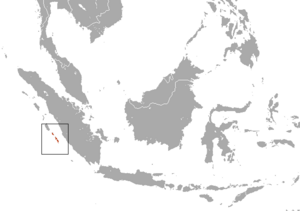Pagai Island macaque facts for kids
Quick facts for kids Pagai Island macaque |
|
|---|---|
 |
|
| Captive Pagai Island macaque, Cisarua, West Java, Indonesia | |
| Conservation status | |
| Scientific classification | |
| Genus: |
Macaca
|
| Species: |
pagensis
|
 |
|
| Pagai Island macaque range | |
The Pagai Island macaque (Macaca pagensis), also known as the Pagai macaque or Bokkoi, is a type of Old World monkey. It lives only on the Mentawai Islands, which are off the west coast of Sumatra. This special monkey is listed as critically endangered on the IUCN Red List. This means it is in great danger of disappearing forever. Its home is getting smaller and smaller. The Pagai Island macaque used to be thought of as the same species as the Siberut macaque, but now scientists know they are different.
What They Look Like
Male Pagai Island macaques are usually bigger than females. Males are about 45 to 55 centimeters (18 to 22 inches) long. Females are a bit smaller, around 40 to 45 centimeters (16 to 18 inches) long. Their tails are also different in length. Males have tails about 13 to 16 centimeters (5 to 6 inches) long. Females have shorter tails, about 10 to 13 centimeters (4 to 5 inches) long.
Males are heavier too, weighing about 6 to 9 kilograms (13 to 20 pounds). Females weigh less, around 4.5 to 6 kilograms (10 to 13 pounds). Their backs are dark brown. The sides of their neck, front of their shoulders, and their undersides are a lighter brown or pale yellow. Their legs are brown, and their arms are reddish-brown. The faces of these macaques have no fur and are black. They have brown eyes. They also have special cheek pouches. They use these pouches to carry food while they are looking for it.
Where They Live and What They Do
Pagai Island macaques live in rainforests. You can also find them in forests near rivers and in swampy areas along the coast. They spend most of their time high up in the trees, in the forest canopy. They look for food between 24 and 36 meters (79 to 118 feet) high. They might even sleep as high as 45 meters (148 feet) up!
Their main food is figs. Sometimes, groups of macaques will split into smaller groups to find food or to sleep. They might even eat alongside groups of another monkey called the Mentawai langur. A group of Pagai Island macaques usually has about 5 to 25 monkeys. Most groups have one male, along with several adult females and their young. The male decides where the group goes. He tells them by making loud, high-pitched calls. Sometimes, a lone male macaque might try to take over the group. This can lead to big fights with the main male.
The natural enemies of the Pagai Island macaque are the crested serpent eagle and the reticulated python. When these predators are seen, the macaques warn their group with a short, rough bark.
Reproduction
The mother macaque carries her baby for about five to six months. Only one baby is born at a time, usually during the night. After the baby is born, the mother eats the placenta and cleans her infant before morning. Mothers and their young stay very close, even as the young monkeys grow into adults.
Population and Threats
These macaques live on the Mentawai Islands, which are about 150 kilometers (93 miles) off the west coast of Sumatra. They live on three of the four main islands: North Pagai, South Pagai, and Sipura.
Sadly, the Pagai Island macaque is now listed as critically endangered. This is because their forest home is being destroyed by people from the Indonesian mainland. The main reasons for this deforestation are clearing large areas of land. This land is used for growing cash crops like palm oil, and for commercial logging. Because of this, the water levels in the forest rivers change a lot more than before. The rivers now have times of flooding and very low water levels. This has also caused more malarial mosquitoes, which can spread disease.


